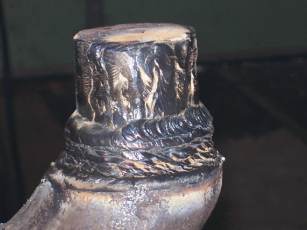

 The scrap box welding fixture. Made from old bearings, a junk lathe chuck, and scrap steel. It can be mounted horizontally or vertically, as the case requires. Note the ground cable clamped on to rotating shaft. A lazy welder simply stands in one spot and rotates the work as welding progresses. No more playing "chase the welding rod". (Photo by Grady Smith). |
 A very ugly horn partially built up with weld. The purpose of the vertical beads were to transform a very oval horn into an approximate circle before building up the entire circumference of the item to assure that the piece would really have adequate material applied in the right places to machine completely. This machinist/welder only likes to build up parts once! (Photo by Grady Smith). |
 A completely built-up horn. The machined diameter will be 2.5 inches. This may or may not be the same horn as the one above. (Photo by Grady Smith). |
 If the piece had been much longer, we would have been in trouble. Note the tailstock of the lathe hanging out past the end of the lathe bed. (Photo by Grady Smith). |
 Side view of mismatched draw-bar pocket arrangement prior to the locomotive being dismantled. Left pocket is not original to the locomotive and has been replaced. (Photo by Chad Thompson). |
 Side view of the almost completed draw-bar pocket, showing it temporarily in place against its mate. (Photo by Grady Smith). |
 Top view of the old draw-bar pocket. Note the oval hole in the pocket. Six inches of slack was present in this assembly prior to rebuilding/replacement of all the various components: both pockets, both pins, and the draw-bar. (Photo by Chad Thompson |
 Top view of draw-bar arrangement, showing the far range of its motion. (Photo by Grady Smith). |